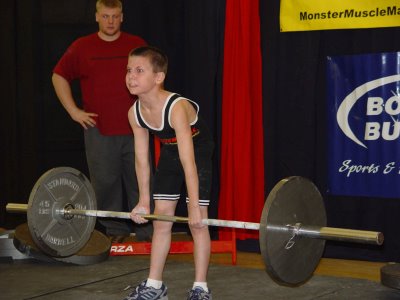Best exercise in Ever: Deadlifts (Duh)
Yep, this is a post about deadlifts that may make you want to throat-punch anyone who tries to tell you lifting smaller weights for higher reps will make you tones and lifting anything over 3 pounds will make you big and bulky.
[youtuber youtube=’http://www.youtube.com/watch?v=gujO4xYSAdo&feature=fvwp’]
You may also spontaneously grow massive followings of admirers of both the opposite sex and even the same sex while trying to read the awesomeness contained within this single post that you have to hire security guards to get through the crowds at your local Starbucks in one piece. I know that’s where you read this blog, you’re not fooling anyone.
I’ve written about deadlifts a lot in the past, the best one being THIS PIECE RIGHT HERE. I have kind of a love-hate relationship with deadlifts. I love doing them all night long, but with a previous back injury to contend with, I can’t hang with the big boys or even the bantam weights who can pull 2 and 3 times their body weight. Compare my current max of 425 (1.89 times my current body weight) to someone like Eric Cressey, who has pulled 660 on video and 700 on a trapbar deadlift, weighing somewhere between 185-195 (roughly a shit-ton more weight than I can pull) and I turn into a Sad Panda.
That being said, there’s something that clicks when you have a copious amount of weight in your grip and you start actually moving that shiz-nit with your musclez. You feel everything, and I mean EVERYTHING working to try to get the weight from shoe-lace level up to just below junk without letting your spine collapse and have a disc shoot across the room to take someone’s eye out. This means that while deadlifting is the straight awesome, it’s also an incredibly technical lift that you can’t quite appreciate until you start getting above 95% of your max. The small details such as weight shift from the front to back of your foot, shoulder blade position, knee angle and breathing (yes, breathing) all become more finite and specific to help get anywhere a good first pull off the floor.
[youtuber youtube=’http://www.youtube.com/watch?v=jz_gi4X9dPY’]
I started doing heavy deadlifts about 2 years ago. Prior to this I was fighting recurrent low back issues from a complete lack of spinal stability. It got pretty bad, to the point where a sneeze caused me to not be able to feel my right leg for a few days, and getting up from the bed was a challenge due to the change in position. I decided a good idea would be to try to build some strength through the area with the best core training exercises known to man, such as deadlifts, more deadlifts, and a seasoning of deadlifts on top.
The downside is that deadlifts are fairly advanced in terms of resisting shear force capacity and the mobility required to get your spine into a decent position to not be stressed too much. This meant I had to take about 4-6 months and put my ego in check, focus purely on movement mechanics, video each workout from different angles, and try to get my form as good as possible. I managed to do pretty well, and now have a goal of hitting a 500 pound pull, and also the splits. This will show I have the stability through the spine, and also the hip mobility of a freakin cheetah on the prowl. I’m 2 inches from the splits and about 75 pounds from 500 (60 on a fantastic day).
Enough about me. Let’s talk about things that interest me, such as deadlifts.
A common misconception about deadlifts is that they are a back exercise. While it’s true that your back is involved, its’ role is more of a stabilizer than a prime mover. THe main movers are the hips, and to a lesser extend the knees. The backs’ role is to buttress the forces created by the hips (yeah, I used a word that had “butt” in it to talk about the hips. I win the clever wars) so that the force of the legs can be transferred efficiently through the core and into the arms, where the bar is conveniently attached and copious iron can be hoisted.
So while the back isn’t directly supposed to flex and extend, it is under pressure and muscular contraction is necessary, but people read into this as saying the back should do the work, meaning we see more than enough spines flopping in the breeze like a slinky walking down stairs and all the hip mobility of a clam driving absolutely no where.
This is why it’s important for the individual performing said holy grail of lifts to know a thing or two about how to actually hip hinge without initiating the movement through their lumbar spine. A great movement I stole from Charlie Weingroff involves standing with feet together and about a foot from the wall, hinging at the hips to try to touch the wall with your butt and getting that massive hamstring and glute stretch with a tense core. The kettlebell is for additional weight while keeping the thoracic spine extended and shoulders retracted.
[youtuber youtube=’http://www.youtube.com/watch?v=ThIHrJiTtz4′]
Once this movement can be performed, then you can actually start lifting things from below your waist height.
One aspect of conventional deadlifts a lot of people find disconcerting is the bar position in relation to the knee almost causes the spine to become elongated or to wind up with a layer of skin missing from the front of your shins. Either way means something less than desirable at the end of the day. One way to get around this at least when learning the movement is to use a small implement like a kettlebell or a dumbbell and work with a wider than shoulder width stance to get the hip hinge pattern down with a weight that is positioned as close to your vertical axis as possible and minimize the strain on your low back.
[youtuber youtube=’http://www.youtube.com/watch?v=vhA1bttA64s’]
A key feature to remember is to keep the shin vertical over the ankle, not collapsing in like Patrick Roy playing goal in the 90’s. This should load up the hamstrings, glutes and adductors without making you want to poop a kidney from low back strain.
From here, the use of a convention deadlift may still not be the best thing to venture into. Instead, a smoother transition would involve using a trapbar, which unfortunately I do not have direct access to.
[youtuber youtube=’http://www.youtube.com/watch?v=deZ3yPHENec’]
The girl in white was TOTALLY CHECKING OUT HIS ASS!!!!
The benefit to a trap-bar deadlift is similar to doing a deadstop deadlift shown above, moving the weight closer to the axis of rotation, minimizing low back strain, and increasing the number of post-lift fist pumps that are possible.
Another option many people tend to gravitate towards are sumo deadlifts. Personally, I don’t do many sumos as I tend to get some shakiness through the knees that makes me feel like a new-born deer taking his first steps, but there are a lot of lifters who get a lot of success using them due to the closer hip position to the floor, shorter range of motion required to hit lockout, and tighter-packed shoulder position.
[youtuber youtube=’http://www.youtube.com/watch?v=LCqcmmByrCw’]
Once someone is confident in doing adapted deadlift positions and they have shown they have the requisite spinal stability and hip mobility to performa conventional deadlift, we can get this party started.
Essentially, a conventional deadlift involves a few things: feet hip width apart, hands shoulder width apart, bar over the mid-foot (NOT the toes), and angry “I hate my mother” music playing in your ears to make your testosterone spike through the roof and make you want to tear into anything with two legs and a heart beat.
After that, we can play with variations, such as deficits, snatch grip, Reeves deadlifts, and anything crazy Ben Bruno can come up with.
[youtuber youtube=’http://www.youtube.com/watch?v=9zpgh5ZGdac’]
[youtuber youtube=’http://www.youtube.com/watch?v=qSQSkW2sXpA’]
[youtuber youtube=’http://www.youtube.com/watch?v=Bp-6qfqi60w’]
[youtuber youtube=’http://www.youtube.com/watch?v=8ZJ_4Mf7E30′]
To see a way more comprehensive post on the biomechanics and technique involved in deadlifting, check out THIS article by Mike Robertson.
Okay, I’m getting antsy just writing this thing. I want to go lift something heavy and then put it down again. Are you deadlifting today? Drop a comment and let me know what you like about deadlifting. If we can get past 100 comments on this post, I’ll put up a full 3-day per week deadlifting program to get your numbers up and perhaps make you taste your lunch from yesterday a little in the back of your throat. GO!!!



35 Responses to Best exercise in Ever: Deadlifts (Duh)